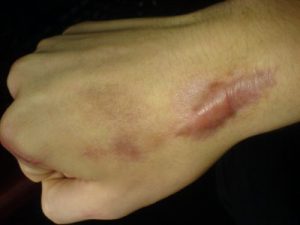Keloid Scar Removal Treatment in Singapore
Get your keloid scar removed by our doctor in our Singapore clinic today.
Featured On:




Once formed, many individuals in Singapore would search for a way to remove or get treatment for their keloid scars. Laser treatments, steroid injections, or even surgery are common ways to remove keloid scars. Let us explore the topic and its nuances.
What are keloids?
Keloids are thick, raised scar tissue above an original wound that has grown beyond the size of the initial injury. This skin condition usually develops around the chest, earlobes, etc., above areas where a wound was healing.
As the wound healths, a keloid scar becomes elevated, thick, lumpy, and may grow progressively in a few months. They can occur whenever there is any damage to the skin, such as a burn, post-surgery, and acne.
Besides being aesthetically unpleasant, it can cause irritation, redness, and cause emotional distress. Early treatment and removal of the keloid scars are recommended. There are different keloid scar treatment options in Singapore, and we will discuss them further in this post.
What do keloids look like?

Here are some images of what a keloid scar looks like. Notice how the scar rises above the skin after it has healed.
What Causes Keloid Scars?
Dermatologists are not certain about the causes of Keloid scars. Most theories say that it is caused by the malfunction of your body’s wound healing process.
As your skin heals from an injury, your cells normally repair it over the area. However, in some cases, the scar would continue and grow over the affected area, causing a keloid.
Who is at risk?
Anyone can develop a keloid scar. However, people of Chinese descent in Singapore are more prone to developing them, according to a few studies. These individuals should be more aware of their risk and seek their keloid scar removed or treated as they grow.
People below the age of 30 are also more prone to develop keloids.
How are keloids diagnosed?
Your doctor or dermatologist can diagnose a keloid scar by visual inspection. Sometimes, your dermatologist may take a small piece of the scar tissue for further examination (a skin biopsy). This is precautionary to rule out other potential skin conditions.
Symptoms
Here are some symptoms of a keloid scar. It is important to know them because they can take months or even years to develop.
Discoloured scar: They may appear in red, purple, or brown hues.
Texture: A keloid usually has a different texture compared to the surrounding skin.
Irritation: Itchy, slight pain or discomfort in the area of the scar
Tell me the best way to prevent keloids?
The primary way of preventing keloids is to avoid skin injuries from happening in the first place. If you are prone to getting keloid scars, you may want to avoid getting tattoos or even ear piercings.
If you get any form of skin damage, please perform proper wound care. Firstly, wash the affected area with soap and water. If you are in Singapore, head to your nearest pharmacy (Guardian, Watson, etc.), get some petrolatum jelly and apply a small layer on top of your wound to keep it moist.
Hypertrophic scars vs. Keloid scars?
Singaporeans commonly ask their dermatologist/doctors about the difference between a hypertrophic and keloid scar. They are actually very similar. Like keloids, a hypertrophic scar happens due to abnormal wound healing. It also has a reddish appearance and grows elevated on the wound. However, the main difference between them is the size of the scars; hypertrophic scars only develop to the size of the injury and are generally easier to treat.
Keloid Scar Removal Treatment Options Available in Singapore
There is no ‘best’ way to treat keloids. Several keloid scar removal treatments are available in Singapore. An experienced dermatologist or doctor in Singapore will usually assess the size of their scar and provide a treatment recommendation.
Fractional CO2 Laser Therapy – Laser skin resurfacing
Fractional CO2 (Carbon dioxide) laser scar revision/laser skin resurfacing is a laser treatment option used by aesthetic doctors or dermatologists for various skin conditions. It is a relatively new treatment option for keloid and hypertrophic scars that has seen wide adoption in Singapore. It is used to reduce discolouration and improve the texture of the scar.
It works by having a machine emit small pulses of light that removes layers of skin from the affected area. A patient would need a few rounds of this laser therapy for a complete treatment.
Pulsed dye laser
Another proven form of laser treatment for keloids is the pulsed dye laser. It was first used in 1993 for keloids and works by breaking up collagen in the scar tissue with high heat.
Steroid Injection
Another common treatment for hypertrophic and keloid scars is steroid injections. The injections used are a class of corticosteroids administered locally in the affected area. Triamcinolone acetonide is usually used for this.
This helps shrink the scar and has strong anti-inflammatory effects on the injected area. These steroid injections can be combined with other treatments like laser therapy.
Can you surgically remove the keloid?
A dermatologist/doctor may recommend surgical removal of your keloid scar. However, this is usually the last option after all other treatments have been used and failed. This is because surgery has side effects, and the recurrence rate is 45% to 100%.
